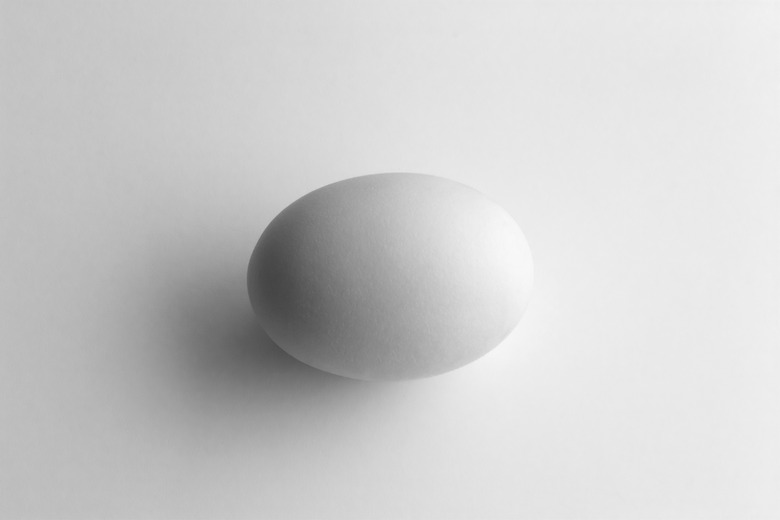How To Calculate The Volume Of An Egg
The density of a chicken egg provides important information about the quality of the egg; the fresher and healthier the egg, the denser it is. To calculate density, you need to know the weight of the egg and its volume. There is an easy way to determine the volume of an egg; by measuring the amount of water it displaces. If you are more mathematically inclined, you can also calculate volume by taking two simple measurements. To perform the mathematical calculation, it is convenient to consider the egg as consisting of two intersecting ellipsoids.
Water Displacement Method
Step 1
Place a cup in a clean, empty bowl and fill the cup to the brim with water.
Step 2
Drop the egg whose volume you want to measure into the cup. It will sink to the bottom, and water will spill out of the cup and into the bowl.
Step 3
Pour the water from the bowl into a measuring cup. The volume of water that you collect equals the volume of the egg.
Mathematical Calculation
Step 1
Measure the width of the egg at its widest point with a ruler or caliper, divide that measurement in half and label that number as R. This is the radius of the minor axis of both ellipsoids that form the egg. Mark the point on the egg at which you took this measurement, using a pencil.
Step 2
Measure the length of the egg and divide this length into two, using the mark you made as the dividing point. Call the longer length L and the shorter length S.
Step 3
Consider the egg as a pair of intersecting ellipsoids. One ellipsoid has radii R, R and L, and the other has radii R, R and S. The formula for the volume of the first ellipsoid is 4/3•pi•R•R•L, but the egg contains only half that ellipsoid, so divide by two. Similarly, the volume of the second half of the egg is 4/3•pi•R•R•S divided by two. Pi is a constant that equals approximately 3.14.
Step 4
Fill in the values for R, L and S in the following formula to find the volume of the egg: 2/3•pi•R•R•(L + S). An egg with a width of two inches (W = one inch) and lengths one inch and 1.5 inches therefore has a volume of 5.233 cubic inches.
Things Needed
- Bowl
- Cup
- Measuring cup
- Ruler or caliper
- Pencil
TL;DR (Too Long; Didn't Read)
If your egg won't sink in a glass of water, throw it away — it's stale.
Considering an egg as an intersection of ellipsoids gives you a good approximation of its volume, but not an exact value. The water displacement method, on the other hand, does provide an exact value (depending on how careful you are with transferring and measuring the water).
Warning
Use only pure water for the displacement method. If the water contains impurities, such as salt, the egg may float.
References
Cite This Article
MLA
Deziel, Chris. "How To Calculate The Volume Of An Egg" sciencing.com, https://www.sciencing.com/calculate-volume-egg-7892704/. 24 April 2017.
APA
Deziel, Chris. (2017, April 24). How To Calculate The Volume Of An Egg. sciencing.com. Retrieved from https://www.sciencing.com/calculate-volume-egg-7892704/
Chicago
Deziel, Chris. How To Calculate The Volume Of An Egg last modified March 24, 2022. https://www.sciencing.com/calculate-volume-egg-7892704/
